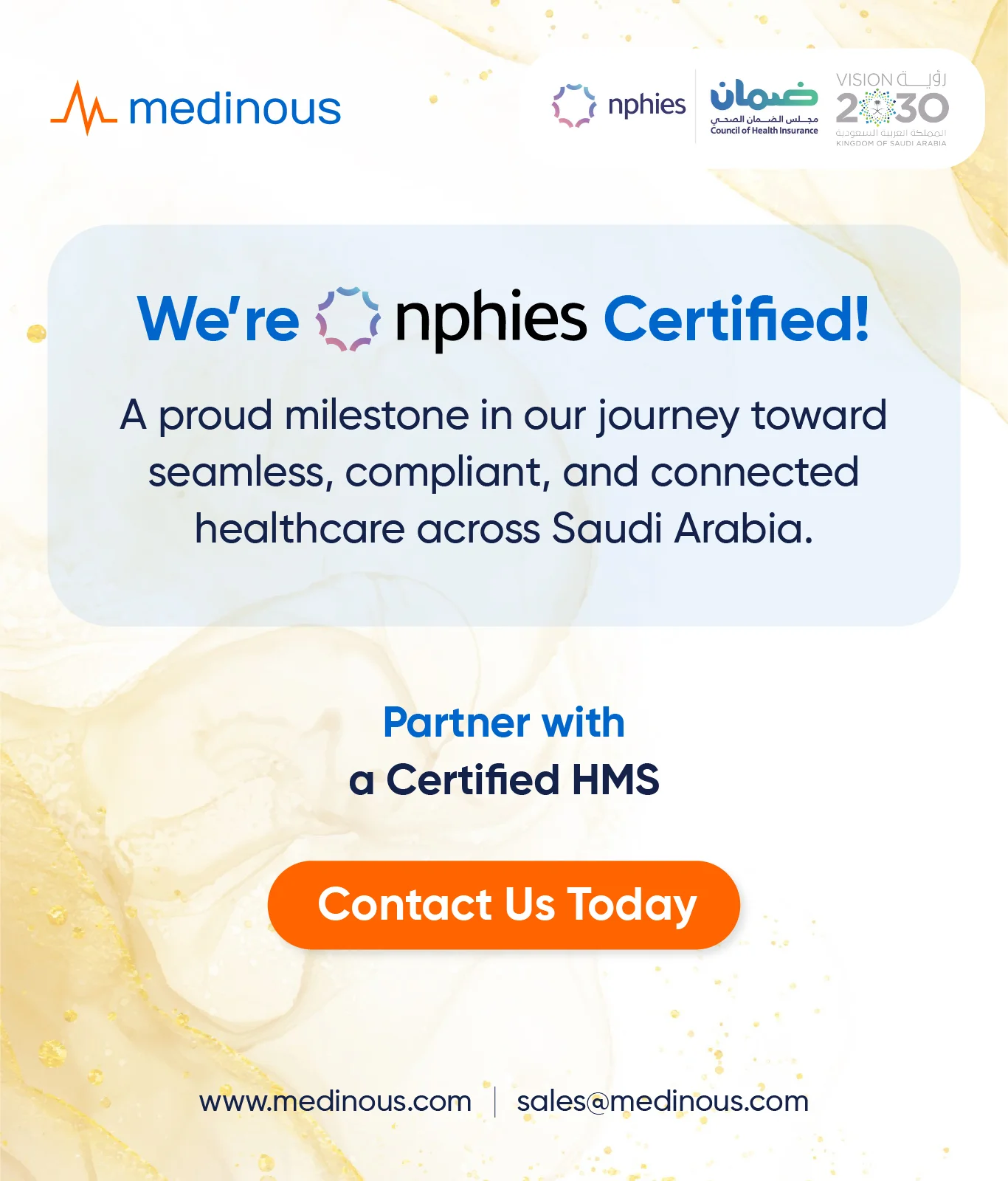Stepping into a hospital for your first HMS pitch? Pause.
Because if you’re a Medinous sales partner, you’re not walking in with a generic product or a quick pitch. You’re walking in with a platform that’s been battle-tested across 10+ countries for 25 years, trusted by leading hospitals and clinics for 25 years, and engineered for one thing: to make healthcare work, even in facilities where resources are stretched and workflows are unpredictable.
Positioning Medinous effectively requires far more than a features demo. In emerging markets, trust must be earned in environments shaped by skepticism, fragmented systems, and legacy workarounds. The real task is guiding providers through a transformation they may struggle to articulate — but urgently need to undertake.
This is your pre-pitch guide. Before the demo. Before the sales call. Before the conversation starts.
The Operational Realities of Emerging Market Healthcare Environments
Healthcare institutions in emerging markets often function within highly complex, fragmented, and under-resourced ecosystems. These environments are characterized by a blend of legacy infrastructure, informal processes, and reactive governance models — all of which present both constraints and opportunities for digital transformation.
Operational hallmarks include:
Partial and inconsistent digitization: Digital systems, if present, are often confined to isolated functions. For example, outpatient registrations might be captured electronically, while pharmacy management remains manual and discharge summaries are handwritten. Interoperability between departments is rare.
Redundant and decentralized data storage: Clinical and administrative data frequently exists in parallel across handwritten registers, Excel sheets, and scanned documents, with no unified data governance or audit trail.
Manually-intensive logistics and diagnostics: Lab results and prescriptions are often physically transported, introducing delay, errors, and procedural ambiguity.
Revenue leakage and inefficiencies: The absence of synchronized billing, real-time insurance verification, and systematic charge capture contributes to frequent financial loss.
Infrastructural volatility: Power instability, internet connectivity challenges, and minimal IT capacity further compound the risk of system failure or partial adoption.
Governance opacity: Decision-making is shaped by a confluence of regulatory uncertainty, donor dependencies, and shifting leadership — often with limited long-term digital strategy.
A successful HMS engagement in these environments demands that partners approach with respect, operational rigor, and grounded realism. The goal isn’t to enforce transformation from the outside, but to enable a guided transition — from fragmented, reactive systems to structured, sustainable operations — without disrupting continuity or clinical integrity.
Medinous: A Platform Engineered for Constraint, Configurability, and Continuity
Unlike conventional EMRs or ERP extensions, Medinous is a dedicated Hospital Management System developed specifically for diverse, high-pressure clinical environments. It is not a one-size-fits-all product but a configurable, modular platform built to accommodate complex realities.
Medinous Product Suite
Distinguishing attributes include:
Low IT dependency: Medinous is deployable in settings with limited infrastructure. The system supports centralized updates, low-latency environments, and requires minimal local technical intervention.
User-centric interface design: The application features intuitive, role-based dashboards and workflows that are easily navigable by frontline personnel — even in facilities with low digital literacy.
Multilingual and localization support: Interface components, system-generated reports, and operational documentation are available in Arabic, French, and English, facilitating inclusivity and minimizing training friction.
Flexible deployment architecture: Medinous can be deployed in on-premise, cloud, or hybrid formats and includes offline capabilities to support uninterrupted operations in low-connectivity zones.
Compliance-integrated frameworks: The platform is natively aligned with healthcare coding and interoperability standards including ICD-10, HL7— reducing regulatory risk and facilitating audit-readiness.
Medinous is best positioned as an institutional infrastructure investment — one that aligns with clinical, administrative, and financial imperatives without overburdening limited capacity.
Stakeholder Navigation: Beyond the Procurement Head
Hospital decision-making in emerging markets does not follow a standardized path. Instead, it is shaped by multiple formal and informal actors whose influence fluctuates across departments and timelines.
Stakeholder clusters typically include:
Administrative decision-makers: They manage procurement and budgets but may not have the clinical or IT depth to assess product suitability. Their focus is on cost containment, ease of implementation, and contract flexibility.
Clinical leadership: Department heads and senior physicians can significantly influence adoption. They often resist changes that disrupt familiar routines or increase administrative burden.
Finance teams: Priorities include revenue cycle integrity, inventory visibility, claims reconciliation, and internal controls. Their support is often essential for any billing or insurance module deployment.
IT consultants or advisors: Often retained for short-term assignments, these actors may offer strong opinions regarding integration, migration, or architecture — even when unfamiliar with Medinous.
Founders, trustees, or board representatives: They are occasionally involved in executive approval, particularly for multi-site rollouts or capital-intensive transitions. Their primary concerns are vendor continuity, service reliability, and institutional risk mitigation.
Importantly, successful implementation hinges on the buy-in of mid-level operational staff — particularly in reception, pharmacy, nursing, and diagnostics. Neglecting their input often leads to poor adoption post-deployment. Achieving alignment across stakeholders requires more than consensus — it calls for thoughtful listening, strategic framing, and communicating tangible value in terms that resonate with each role.
Achieving alignment across stakeholders requires more than consensus — it calls for thoughtful listening, strategic framing, and communicating tangible value in terms that resonate with each role.
Understanding Resistance: Why HMS Projects Fail Without Foresight
Hospital Management System implementations often falter not because the technology is inadequate, but because the organizational terrain is misunderstood. Resistance tends to emerge from perceived disruption, a lack of operational clarity, and institutional memory of past failures.
Common resistance triggers include:
Workflow disruption fears: Staff worry that digital tools will slow them down, particularly during peak patient loads or emergencies.
Vendor fatigue: Prior disappointments with software providers create skepticism about post-implementation support and long-term reliability.
Undefined operating procedures: Many facilities have no standardized, documented workflows, making it difficult to map or migrate to a digital system effectively.
Interface overwhelm: Complex, unintuitive systems that demand rigid inputs often alienate users accustomed to flexible, paper-based processes.
No internal ownership: Without a designated change advocate, new systems are seen as externally imposed — leading to disengagement and poor uptake.
The most effective implementations reduce friction by staging rollouts, aligning training to real workflows, and securing quick, visible wins that restore confidence and demonstrate progress.
Driving Adoption: What Actually Works in the Field
Medinous is designed to align with real-world behavioral patterns in clinical operations — not impose abstract digital frameworks. Adoption is a function of perceived benefit, operational familiarity, and post-go-live support.
Key drivers include:
Incremental process substitution: Rather than forcing radical process change, Medinous gently replaces high-friction activities (e.g., stock reconciliation, billing entry) with more efficient workflows.
Staggered implementation: Starting with one or two departments, partners can build momentum through measurable improvements before scaling across the facility.
Role-specific training modules: By tailoring training to specific responsibilities, users retain more and require less post-deployment handholding.
Offline-first reliability: The ability to operate independently of live internet connections enhances confidence among users in remote or resource-constrained settings.
Transparent results: Admins and department heads are more likely to champion the system when they can quantify improvements in process speed, data visibility, or claims performance.
Strategic Positioning: Focus, Sequence, and Restraint
A feature-rich system offers broad possibilities — but successful engagements begin with discipline, not demonstration. In under-resourced or fragmented environments, what you choose to show first can determine whether a sale progresses or stalls.
Lead With:
- Operational gains in registration, pharmacy, billing, and core clinical documentation
- Readiness for local compliance with regulatory and insurance standards (e.g., NHIS, HL7, CCHI)
- Flexible deployment models aligned with available infrastructure (on-premise, hybrid, cloud)
- Service continuity assurances and a clearly defined local support model
- Time-bound, achievable implementation plans that prioritize stability
Defer Until Later:
- Advanced modules like business intelligence, population health, or predictive automation
- Multi-branch interoperability or centralized reporting unless it’s a present, stated need
- Deep customizations, AI logic trees, or extended API integrations that may distract from near-term goals
The objective is not to showcase every capability, but to build credibility through relevance. Trust is the prerequisite for ambition.
Discovery Before Demonstration: Shaping the Right Narrative
No walkthrough should begin without a structured discovery process. Understanding the institution’s context, constraints, and workflows transforms a generic demo into a meaningful conversation.
Discovery areas to explore:
- Registration and billing flows: Who initiates the process? How is billing sequenced and tracked?
- Clinical documentation: What tools are currently used? Where do records stall or get duplicated?
- Pharmacy and diagnostics: How are prescriptions and lab requests handled? What tracking gaps exist?
- Insurance and claims: Which formats are in use? What are the common rejection patterns or reconciliation issues?
- Previous technology exposure: What systems have been tried before? Why did they fall short?
- Decision-making architecture: Who influences selection, implementation, and training? What are their operational fears?
These conversations are not just about gathering information — they lay the foundation for a pitch rooted in reality. You’re not offering abstract functionality; you’re solving problems the institution already faces.
Stewardship, Not Sales: Shaping Lasting Outcomes
In complex healthcare environments, success isn’t defined by go-live dates. It’s measured by the durability of change and the institution’s ability to thrive post-implementation.
To lead such change is to act as a steward — someone who aligns technology with real-world resilience, financial visibility, and clinical confidence.
The long-term impact includes:
- Improved cost recovery via structured billing and insurance workflows
- Reduction of data silos and administrative duplication
- Faster reimbursements through standardized, compliant claims processes
- Strengthened institutional governance through digital traceability and controls
- Higher staff morale enabled by intuitive, non-disruptive interfaces
Technology alone doesn’t drive transformation. It’s the ability to listen, adapt, and support that turns capability into continuity.
Where Technology Meets Institutional Maturity
Introducing hospital management systems in emerging markets is about more than delivering software — it’s about supporting healthcare institutions as they strengthen operations, improve continuity, and build the foundations for long-term digital maturity. While the challenges are real, so is the opportunity to make meaningful, lasting improvements to how care is delivered and managed. Medinous offers a platform that’s been shaped by this understanding — adaptable, resilient, and built to align with the pace of each institution’s journey.
If you’re looking to engage with healthcare providers in a way that’s thoughtful, collaborative, and rooted in real-world needs, we welcome you to explore the Medinous Partner Program. It’s designed to support those who want to work not just with a product, but with a proven approach — one that combines structured implementation, regional insight, and long-term support.
Visit the Medinous Partner Program to learn more and share your interest. We’ll be glad to connect and explore how you can play a role in enabling smarter, stronger healthcare systems.



